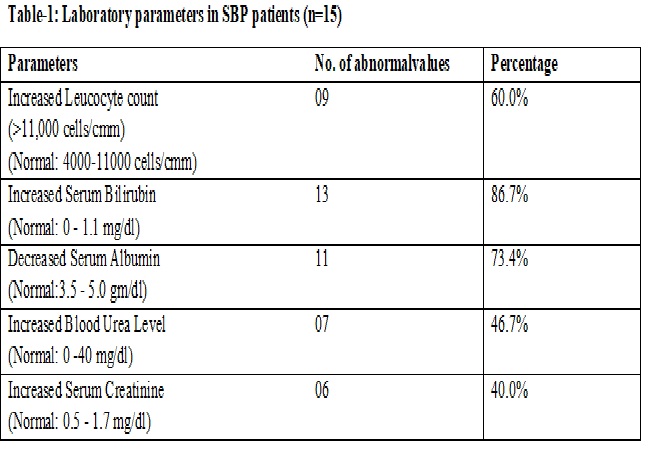A study of biochemical parameters and microbial organisms in ascitic fluid of spontaneous bacterial peritonitis patients
Abstract
Introduction:Spontaneous Bacterial Peritonitis (SBP) is recognized as a severe complication in patients of ascites. In recent years, it has also been diagnosed in patients without liver disease. SBP is commonly reported in patients of ascites due to cirrhosis of liver. If untreated, SBP could be a fatal complication in patients of ascites.
Objective:To study the ascitic fluid biochemical parameters and causative micro-organisms in patients suffering from SBP.
Materials and Methods:A prospective study was performed on 100 patients of ascites out of which 68 were males and 32 were females. After admission all patients were interviewed and detailed history and complete physical examination was performed.
Results:In this study 86.7% patients had increased serum bilirubin levels, 73.4% patients had decreased serum albumin, 46.7% and 40% patients had increased blood levels of urea and creatinine respectively. 60% patients had ascitic fluid pH < 7.30 while 80% patients had ascitic fluid proteins < 1 gm/dl. All patients had >250 polymorphonuclear cells/µL and 80% patients had >500 polymorphonuclear cells/ µL in ascitic fluid. 46.7% cases of SBP were culture positive and 53.3% were culture negative.Gram staining of ascitic fluid was positive in one case.
Conclusion:Hypoalbuminemia, hyperbilirubinemia, low ascitic fluid pH, low ascitic fluid proteins, increased blood urea and creatinine levels are risk factors related with development of SBP in patients of ascites.The commonest micro-organism identified on culture were E-coli.
Downloads
References
Jeffery J, Murphy MJ. Ascitic fluid analysis: the role of biochemistry and haematology.Hosp Med. 2001 May;62(5):282-6.
Horn S, Holzer H, Horina JH. Spontaneous bacterial peritonitis in a patient with nephrogenic ascites during an episode of acute renal transplant rejection. Am J Kidney Dis. 1996 Mar;27(3):441-3.
Runyon BA. Spontaneous bacterial peritonitis associated with cardiac ascites. Am J Gastroenterol. 1984 Oct;79(10):796.
Kurtz RC, Bronzo RL. Does spontaneous bacterial peritonitis occur in malignant ascites? Am J Gastroenterol. 1982 Mar;77(3):146-8.
Woolf GM, Runyon BA. Spontaneous Salmonella infection of high-protein noncirrhotic ascites. J Clin Gastroenterol. 1990 Aug;12(4):430-2.
Correia JP, Conn HO. Spontaneous bacterial peritonitis in cirrhosis: endemic or epidemic? Med Clin North Am. 1975 Jul;59(4):963-81.
Amarapurkar DN, Viswanathan N, Parikh SS, et al. Prevalence of spontaneous bacterial peritonitis. J Assoc Physicians India. 1992 Apr;40(4):236-8.
Conn HO, Fessel JM. Spontaneous bacterial peritonitis in cirrhosis: variations on a theme. Medicine (Baltimore). 1971 May;50(3):161-97.
Conn ho. Spontaneous peritonitis and bacteremia in Laennec's cirrhosis caused by enteric organisms. A relatively common but rarely recognized syndrome. Ann Intern Med. 1964 Apr;60:568-80.
Weinstein MP, Iannini PB, Stratton CW, Eickhoff TC. Spontaneous bacterial peritonitis. A review of 28 cases with emphasis on improved survival and factors influencing prognosis. Am J Med. 1978 Apr;64(4):592-8.
Guarner Carlos, Ricard Solaet al: Risk factor of a first community-acquired Spontaneous Bacterial Peritonitis in cirrhotics with low ascitic protein level. Gastroenterology, 1999;117(2):414-19.
Andreu M , Sola R, Sitges-Serra A, et al. Risk factors for spontaneous bacterial peritonitis in cirrhotic patients with ascites. Gastroenterology. 1993 Apr;104(4):1133-8.
Casafont F, Rivero M, Fernandez MD, et al. Granulocyte elastase in cirrhotic patients with spontaneous bacterial peritonitis. Dig Dis Sci. 1999 Oct;44(10):1985-9.
Huber M, Schwarz W, Vogl T, Zeuzem S. [Clinical aspects of liver cirrhoses and its complications and diagnostic problems]. Radiologe. 2001 Oct;41(10):840-51.
Scemama-Clergue J, Doutrellot-Philippon C, Metreau JM, et al. Ascitic fluid pH in alcoholic cirrhosis: a reevaluation of its use in the diagnosis of spontaneous bacterial peritonitis. Gut. 1985 Apr;26(4):332-5.
Runyon BA, Hoefs JC. Ascitic fluid chemical analysis before, during and after spontaneous bacterial peritonitis. Hepatology. 1985 Mar-Apr;5(2):257-9.
Gençer S, Ozer S. Spontaneous bacterial peritonitis caused by Brucella melitensis. DOI: https://doi.org/10.1080/00365540310000238
Albillos A, Cuervas-Mons V, Millán I, et al. Ascitic fluid polymorphonuclear cell count and serum to ascites albumin gradient in the diagnosis of bacterial peritonitis. Gastroenterology. 1990 Jan;98(1):134-40.
Almdal TP, Skinhøj P. Spontaneous bacterial peritonitis in cirrhosis. Incidence, diagnosis, and prognosis. Scand J Gastroenterol. 1987 Apr;22(3):295-300.
Jain AP, Chandra LS, Gupta S, et al. Spontaneous bacterial peritonitis in liver cirrhosis with ascites. J Assoc Physicians India. 1999 Jun;47(6):619-21.



 OAI - Open Archives Initiative
OAI - Open Archives Initiative


